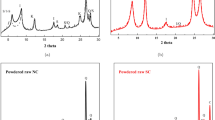Abstract
In this article, full use of clay materials in the processing of Longquan celadon clay is presented. The microstructure and chemical compositions of the Longquan celadon samples were characterized by an x-ray fluorescence spectrometer, x-ray diffraction, and scanning electron microscope/electronic differential system analysis. The results showed that Longquan celadon has high SiO2 and Al2O3 contents, resulting in better transparency and gloss compared with other celadon types. The structure scattering and chemical coloring of Fe2O3 also affected the color characteristics of the glaze surface including the opacity and color saturation. We observed an increase in the blue tone of the Longquan celadon, attributed to several factors including the phase separation of the droplets to form structural color by Rayleigh scattering and amorphous photons. We made full use of clay raw materials to produce Longquan celadon and compared it with the traditional method, thereby disposing of the tailing waste and reducing the environmental pollution resulting from it.





Similar content being viewed by others
References
B.Q. Zhu, The Light Industry Hall of Zhejiang Province, Study on Longquan Celadon, 1st ed. (Beijing: Cultural Relics Press, 1989), pp. 1–37.
J. Wu, M.L. Zhang, T.J. Hou, Q.J. Li, and J.M. Wu, Ceram. Int. 41, 6851 (2015).
J.Z. Li, The History of China Science and Technology (Ceramics) (Beijing: Science Press, 1998), pp. 10–20.
Z.Y. He, M.L. Zhang, and H.Z. Zhang, Ceram. Int. 42, 5123 (2016).
T.Q. Zhu, H. Huang, H.M. Wang, L.M. Hu, and X.B. Yi, J. Archaeol. Sci. 38, 3134 (2011).
L. Li, S.L. Feng, X.Q. Feng, Q. Xu, L.T. Yan, B. Ma, and L. Liu, Nucl. Instrum. Methods B. 292, 25 (2012).
J. Wu, Y. Zhang, J.M. Wu, Q.J. Li, J.Z. Li, Z.Q. Deng, and J. Xia, Sci China Technol SC. 54, 99 (2011).
P. Shi, F. Wang, J.F. Zhu, B. Zhang, T. Zhao, Y. Wang, and Y. Qin, Ceram. Int. 43, 2943 (2017).
R. Zhou, Y. Guo, and Y. Wang, Research on raw materials of Longquan celadon. Researches in Chinese Ancient Ceramics, 1st ed., ed. R. Zhou (Beijing: China Light Industry Press, 1982), pp. 74–98.
F.K. Zhang, Scientific and Technical Research Achievements in Ancient Chinese Pottery and Porcelain, 1st ed. (Shanghai: Science and Technology Press, 1985), pp. 161–168.
J.Z. Li, History of Science and Technology of Ancient Chinese Ceramics, 1st ed. (Beijing: Science Press, 1998), pp. 117–157.
T. Sekiya, K. Ichimura, M. Igarashi, and S. Kurita, J. Phys. Chem. Solids 61, 1237 (2000).
T.Q. Zhu, F. Wu, J.L. Wan, M. Wang, B.K. Ahamed, C.J. Liu, and Z. Wang, J. Archaeom. 60, 42 (2018).
J.M. Miao, C.L. Lv, H. Li, and T.M. Chen, J. Archaeom. 54, 955 (2012).
W.D. Li, J.Z. Li, Z.Q. Deng, J. Wu, and J.K. Guo, Ceram. Int. 31, 487 (2005).
Y. Huang, L.T. Yan, H.Y. Sun, and X.Q. Feng, J. Archaeom. 60, 54 (2017).
L. Breiman, Random For. Mach. Learn. 45, 5 (2001).
L. Breiman, J. Friedman, C.J. Stone, and R.A. Olshen, Classification and Regression Trees, 1st ed. (Washington: CRC, 1984), pp. 122–156.
T.Q. Zhu, X. Ding, C. Kusimba, and Z.Y. Feng, Ceram. Int. 41, 9878 (2015).
K. Chung, S. Yu, C.J. Heo, J.W. Shim, S.M. Yang, M.G. Han, H.S. Lee, Y. Jin, S.Y. Lee, N. Park, and J.H. Shin, Adv. Mater. 24, 2357 (2012).
Y. Takeoka, J. Mater. Chem. 44, 23299 (2012).
T. Yamashita and P. Hayes, Appl. Surf. Sci. 254, 2441 (2008).
J.Z. Li, Z.Q. Deng, and Z.G. Zhang, Study on the Black Slipware and Proto–Porcelain from Jiangshan, Zhejiang Province, 1st ed. (Beijing: Science Press, 1987), pp. 56–63.
R. Zhou, Y.Y. Guo, and M.Y. Wan, Research on the Raw Materials of Longquan Celadon, 1st ed. (Beijing: Cultural Relics Press, 1998), p. 133.
O. Mamdouh, F. Timo, E.M. Ahmed, A.K. Nagui, E.A. Mortada, and E. Abd El-Hamid, Appl. Surf. Sci. 345, 127 (2015).
Acknowledgements
This work was supported by the Bureau Commonweal Foundation of Lishui City Science and Technology, Zhejiang Province, China (2015sjz01), the Key Laboratory of Digital Design and Intelligent Manufacturing for Creative Cultural Products of Zhejiang Province, China (2016E10007), and the Longquan Celadon Collaborative Innovation Center of Zhejiang Province, China (PY2016QCXT08). The authors thank Qibing Chang, Yongqing Wang, and Na Zhang for their helpful discussions on the analysis of the experimental data.
Author information
Authors and Affiliations
Corresponding author
Rights and permissions
About this article
Cite this article
Shi, Q., Hassan, D.A. New Longquan Celadon Technology to Reduce Environmental Pollution. JOM 71, 1016–1023 (2019). https://doi.org/10.1007/s11837-018-3246-9
Received:
Accepted:
Published:
Issue Date:
DOI: https://doi.org/10.1007/s11837-018-3246-9




